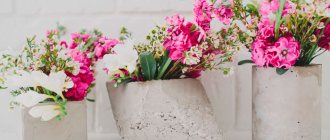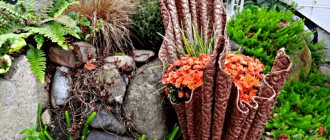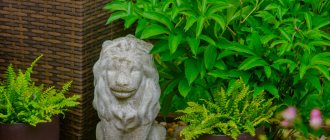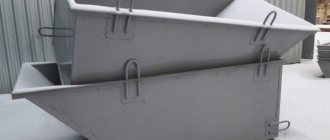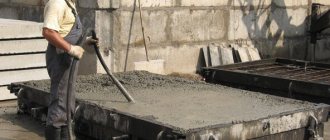Decorating your home interior or local area is an exciting activity. Some people hire professional designers to do this, while others like to do it themselves. But everyone wants to arrange their personal piece of the planet in a non-standard, original and beautiful way. Concrete can be very helpful in this matter - the material is accessible, inexpensive and very plastic. Paving and facing tiles, flower beds and flowerpots made of cement can decorate the garden, and flower pots, vases and other decorative vessels can transform the interior. They are not difficult to make, and in this article you will find some interesting ways.
Anyone can make such floor vases Source na-dache.pro
Manufacturing options
Concrete mortar is a fairly plastic material, so there are a lot of ways to create products from it. You can make flowerpots in a wide variety of shapes and sizes. Take a look at the photos below to see for yourself.
Decorate finished products to your taste
Decor option
Vase made of concrete and wood finishing
Durable building material requires compliance with the rules for preparing the solution. A high-quality mixture consists of 1 part cement, 2 parts sand, 4 parts aggregate, 0.5 parts water. To increase the strength of the structure, a reinforced frame is used.
The glossy surface is formed by sanding with a special machine using a felt wheel and paste. After processing, the product is coated with a layer of polymer composition.
To make flower pots from concrete and wood trim, you need to take a juice box and cut off the top. The filling composition is prepared by mixing the ingredients with the addition of water. To reduce the number of bubbles in the mixture, add a little more liquid.
The prepared composition is poured into the box. After this, the cut-off part of a smaller size is lowered into the mold filled with the mixture and pressed into place to a depth of 2-3 cm and secured with tape. The product is left for several hours so that the concrete takes on the desired configuration.
After the concrete takes its final form, remove the boxes that act as forms and proceed to surface treatment using a grinding machine. For wooden finishing, blanks are cut taking into account the dimensions of the concrete frame. The bars are fastened with a stapler, and the metal plate is screwed on using an electric drill.
The fasteners are securely fixed and attached in a vertical position. Finally, you should test the finished product and check the tightness of the connection to the pot.
Among the variety of finishes, the combination of concrete with a wooden stand is considered successful. An excellent combination of artificial stone and solid wood involves the manufacture of a product consisting of 2 complementary parts.
Option one
Necessary materials:
- ordinary or white cement, grade M 400;
- sifted sand;
- gravel from 3-7 mm;
- pure water;
- wire for wall reinforcement;
- container for mixing the solution;
- paint (optional);
- polyethylene film;
- grease, grease or special lubricant to separate the mold and the finished product;
Forms for pouring. You can choose absolutely any form for the solution; these can be plastic bottles, pots, buckets and even cardboard boxes, the corners of which are glued with tape to strengthen them.
Preparing the mixture
- Take 2 parts cement, 3 parts sand and 3 parts gravel, then mix sand and cement, add gravel and mix well. To reduce the weight of the resulting product, part of the gravel can be replaced with fine expanded clay.
- Gradually add water to the resulting mixture in small quantities and mix everything again. If you want to get the product in color, you should add a concrete pigment to the solution. The finished mixture should be homogeneous and thick.
Filling a flowerpot
- For convenience, the surface of the inner mold and the outer mold should be coated from the inside with grease or a release agent; some use vegetable oil.
- Cover the bottom of the outer mold with a layer of mortar 5-6 cm thick, level the surface and install the inner mold. If the internal form does not provide sufficient wall thickness, it is necessary to strengthen them with reinforcing wire , place it in the center of the proposed wall, and then fill it with mortar.
- Cover the mold with film or a damp cloth and leave in the shade for 3-4 days, during which time the solution should completely set. In order not to complicate your work and not to drill the necessary drainage holes in already hardened concrete, you can place several tubes before pouring the solution; their height should be equal to the thickness of the walls and bottom.
- After a few days, we remove the product from the outer mold (if thin plastic or cardboard was used, it will be easiest to carefully cut it) and leave it in the shade to dry completely. This may take up to 2 weeks; it is advisable that during this time the flowerpot is wrapped in plastic film or moistened with water to prevent cracks from appearing on the surface.
- The finished flowerpot can be painted with special paint or decorated with pebbles, mosaics, as well as sea and river shells.
Photo source: www.postroiv.ru
Video description
An example of making a flowerpot from a stocking and a tin can can be seen in the video:
Method 3 - sculptural
This method of making a flowerpot from cement is quite complex and requires artistic imagination and experience in sculpting and carving.
Experienced craftsmen use wet fine sand as the basis for creating the mold. It is poured into a suitable container, compacted thoroughly, and then the container is turned over onto a flat surface and removed. If you made sand cakes as a child, then you understand the technology. After the concrete has hardened, the sand can be easily removed from the flowerpot.
The resulting Easter cake is carefully doused with the solution and spread with a spatula over the entire surface. It is important to choose the correct thickness of the cement mixture. When this layer has set, prepare a thicker solution and begin decorating the walls. If you have no experience, you can start by simulating masonry, making lumps of different sizes from the mortar, gluing them to the walls and giving them shape. Then the excess mixture is selected between them, forming relief depressions - seams. When decorating, they are highlighted with color.
An example of a “stone” pots Source vkusnahka.ru
Vivid examples
There are a lot of ideas and unusual examples. Refined natures will appreciate a flowerpot in the shape of palms. They do it as follows. You need to fill latex gloves with the solution. Then, before they harden, you need to give them the shape of hands that carefully hold the flowers.
Hungarian technology also has its fans. It is as follows. The forms are plywood templates with a semicircular recess and wire loops on the sides.
Proceed as follows:
- A mixture of cement and sand is poured into the center of a sheet of roofing felt or plywood. It is necessary to mix everything thoroughly and form a slide. A hole is made in it, into which water should be carefully poured.
- You need to immerse the template rod into it. This is how the internal walls are created. The rod is rotated in the same way as professional potters work. The mixture produces a hemisphere. A film is placed on top. Then mix again. Then a metal mesh. There is another layer of solution on it.
- Finally, you need to use the second template. It will support the outer walls of the future masterpiece. You will create an amazing fantasy structure that will be completely different from heavy cement monuments. Now you can pull out the rod and wait until the product dries well.
- If you think that the flowerpot looks plain, you can decorate it. Painting with acrylic paints will look stylish. Staining concrete is very easy. It is only important to thoroughly prime the entire surface and only then apply painting. Also, don't be too zealous in terms of palette. It is important that the decorations do not dominate in color over the flowers that you will grow in this container.
To make the surface shimmer in different colors, you can decorate the flowerpot with a mosaic. Pieces of tiles can act as mosaics. A thick layer of glue is first applied to the flowerpot. Then the tile pieces are distributed. In this case, each element is pressed into glue.
The same method is suitable for decorating a flowerpot with pebbles.
In this case, it is important to be careful. It is necessary to immediately clean the pebbles from glue. If it dries out, it will be impossible to clean them. In order for the surface to look elegant, the gaps must be rubbed after the glue has dried. Flowerpots with mosaics in Indian or Byzantine style look very stylish.
Design advantages
Concrete pots and planters are becoming more and more popular. They look unusual and interesting, in addition, due to their similarity with stone, they fit well into any interior and garden. With their help, it is easy to perform zoning of the territory.
Other benefits include the following:
- Cement is not afraid of fire and water, it tolerates any weather conditions well, therefore, it can be used outdoors;
- Almost any plant takes root well in a cement pot, since the material is environmentally friendly;
- Cement mortar easily takes any shape, and unusual containers can be made from it;
- During hardening, any pattern or stamping can be applied to the container; after drying, the walls can be painted;
- Thanks to the weight, the flowerpots will not fall even in strong winds;
- The pot will be extremely durable;
- Cement is inexpensive, and any container can be used as a mold.
Cement planters look good outdoors, as well as in romantic, minimalist or industrial styles. They look great on the table with small succulents, on the floor with larger plants, or outdoors as open planters.
Source coposic.ru
Hanging planter
If you have limited space at home, you can hang the pots. For manufacturing you will need metal triangular plates. Cement mortar without filler is spread on them with a layer of 3-5 mm. Having made three such plates, they need to be combined into a single structure, coating the joints with cement mortar. Even before complete hardening, a hole should be made in each plane. A rope will be threaded through them.
Conclusion
In general, it is quite possible to make not only an “eternal”, but also an exclusive flowerpot yourself. Concrete, a little ingenuity and imagination and years of admiring not only the content, but also the form.
In recent years, the loft style has become increasingly popular, and with it concrete, not only in gardening, but also in the interior. Concrete makes excellent functional and very original furniture. No less interesting is a material such as tadelakt - it is not only the oldest type of plaster, but also an excellent material for covering concrete sinks. The video shows the first experience of landscape design.
Subscribe to our Telegram channel Exclusive posts every week
An easy way to create original jewelry
Spring has come, it's time to plant flowers in balcony boxes and flowerpots. Good large flowerpots are expensive, they are heavy, and do not always meet our expectations in size, shape, and color. Lighter pots are fragile and not resistant to frost. An interesting alternative to purchased flowerpots are homemade pots made from concrete using various shapes and decorative methods.
It is important to choose the right size of pots. The dimensions depend on the dimensions of the form used.
Worth knowing:
- The wall thickness of a large container should be about 5 cm to ensure strength;
- for a small pot, a thickness of 1 cm is sufficient;
- for a large container with a width and height exceeding 50 cm, the minimum thickness is 7-8 cm.
Let's sum it up
Instead of buying expensive flower pots, you can easily make your own. This work does not require special precision, skills, or equipment. An old bucket or pot found in the attic can start a new life as an unusual flowerpot. Concrete pots look good in the garden and are durable. Homemade flower pots can be imperfect, and that's the beauty of them. Plants grow well in them and look harmonious in modern gardens. Their small size fits into some modern styles.
Caring for concrete pots is as easy as caring for plastic pots - just wash with water. Homemade pots are not only an easy way to create a functional, original decoration, but also a lot of fun from the work done!
Modern trends in landscape
Concrete flowerpots add a special presentability to the owners of a garden, cottage or estate.
Flower bowls both decorate the area and perform the function of a flower garden: they house both floral and decorative crops.
Both annual and perennial plants are planted in flowerpots.
Trends in decorating local areas dictate to home garden owners that bowls and flowerpots be made from materials that closely resemble natural ones.
Decorating cottages and courtyards from natural stone is not an easy and expensive job. It has become practical to use ordinary concrete and cement mortar to create flower arrangements.
Designers consider concrete vases not only original, but also functional. With the help of volumetric bowls you can:
- Create a special aura on the site.
- Concrete vases can be used to zone a space, collecting its details into the overall picture.
Massive flowerpots are actively used by decorators in private plots, parks, at the entrance to cultural institutions, and in administrative buildings.
Concrete bowls have many advantages that make them popular:
- vases are affordable, their construction or purchase will not break the budget;
- concrete is not afraid of moisture, frost, flame, it is quite durable;
- availability of bowls (vases, etc.) for the implementation of all kinds of ideas: vases can take on any, the most bizarre shape;
- environmental friendliness and mobility: green spaces grow well in such vases; for capricious plants, you can choose an exclusive area for mounting the bowl;
- outdoor vases can be created in the style that the customer prefers;
- Concrete is easy to paint and can be finished, so flowerpots can be decorated in any color scheme.
Large concrete pots made from old buckets
Massive improvised objects are used to make decorative elements used in landscape design. A master class on making flower pots with your own hands can be taken at specialized art centers in Moscow.
The principle of working with concrete when using old buckets is reminiscent of making Easter cakes. To make a cement pot without voids, the substance should be mixed well, and pebbles should be added to obtain a shaped accessory.
Large pots are decorated with multi-colored tiles and accessories. Before you start working with the cement composition, it is recommended to protect your hands from exposure to concrete. You should work with gloves. If a crack appears in the finished product when removed from the mold, the defect must be eliminated by covering it with fresh solution.
How to make a cactus pot from concrete and glass
The decorative element for succulents is simple and does not require financial costs. To make concrete pots for cacti, take glass molds, wash them and wipe them dry. After spraying white or black paint, the workpiece is left to dry.
The preparation of the cement mixture is carried out taking into account the recommendations. In this case, it is important to achieve a thick consistency of the material that will be held on the surface of the mold. The glass frame is lowered into the mixture.
To color the composition and give the concrete a different shade, an emulsion is applied to part of the form before it hardens. If the concrete has dried, the coloring composition is again applied to the surface to achieve a uniform and bright shade.
To make a concrete pot look original, the monochromatic color is diluted with contrasting lines, splashes, and patterns. The glass frame can be installed in the mold so as to leave part of the product transparent. The choice of base configuration and product design depends on personal preferences and creative ideas.

